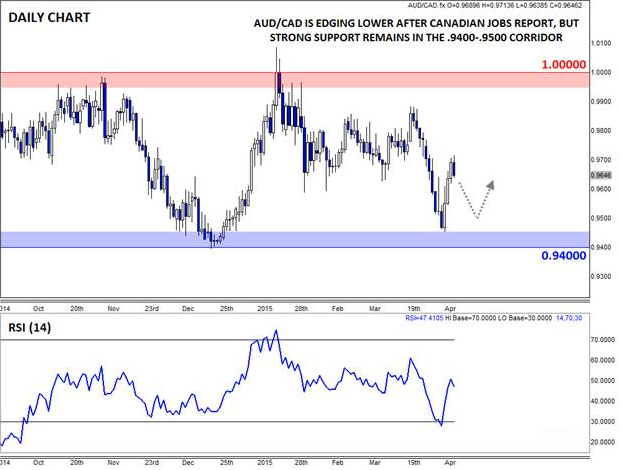There’s a dearth of US economic data today, but that hasn’t stopped the USD from building on its gains from earlier this week. The greenback’s latest rally has driven GBP/USD to a new 5-year low under 1.4600, EUR/USD to within striking distance of its 12-year low near 1.0500, and USD/CHF to above .9800. While the dollar’s rally remains the dominant theme in the forex market, traders’ collective attention shifted “North of the Border” at the start of today’s North American trading session for the release of the Canada’s March jobs report.
Drawing a sharp contrast with the US, Canada’s labor market produced a solid 28.7k jobs in March, far more than the essentially flat reading expected. More to the point, the unemployment rate in the Great White North unexpectedly held steady at 6.8%, besting expectations that it would tick up to 6.9%. Much of Canada’s recent economic data has been disappointing, prominently including Monday’s dismal Ivey PMI report, so today’s strong jobs report is a beacon of hope for an economy struggling to adjust to the current environment of low oil prices. Before CAD bulls ring the victory bell though, it’s important to note that full-time jobs actually declined in March; the headline increase was driven entirely by growth in part-time employment.
Market Reaction
We’ve already covered USD/CAD extensively this week (see here and here for two examples), and the pair remains roughly in the middle of its established range from 1.24 to 1.28 in the wake of the labor report, leaving little in the way of new trade opportunities. Looking a bit further afield, AUD/CAD has turned lower to trade at .9650 after the report, reversing some of the gains from the mid-week rally. This commodity dollar pairing may continue to edge lower heading into next week, but strong support in the .9400-.9500 corridor could put a floor under any near-term dips.

Source: FOREX.com
For more intraday analysis and market updates, follow us on twitter (@MWellerFX and @FOREXcom)
